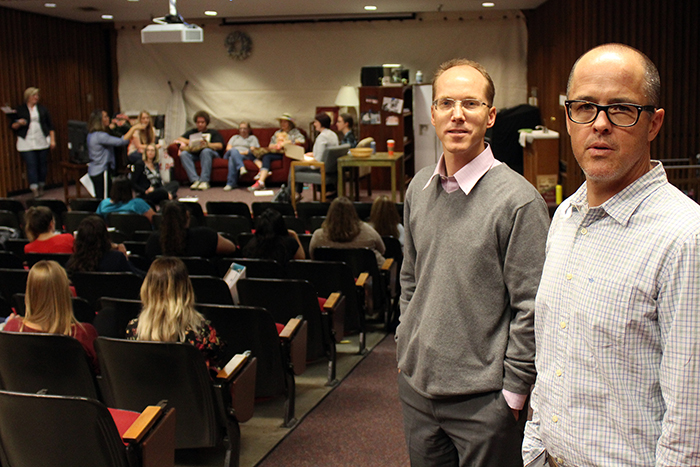Changing the Way Child Welfare Workers Learn

At one point in history, if you wanted to be a pilot, you got into a plane and flew. If you landed, you were a pilot. If you didn’t, you weren’t. But no one expects a pilot to do this today. Their training and methods have evolved to the point that they can be trained almost entirely in a simulator before ever entering a plane. A commonly accepted method of training in many social work professions isn’t dissimilar from the old way of training pilots – just dive in. Go in to the home. Get your feet wet. Research Associate Professor Matt Davis and Research Assistant Professor Chad McDonald are trying to create a similar change in social work training. Dr. Davis explained, “We know better ways of learning. We have better ways of training. We should apply these to the practice of social work.”
With Prof. McDonald’s background as a Division of Child and Family Services (DCFS) trainer and administrator and Dr. Davis’ background studying the effectiveness of innovative learning approaches, these two seem a perfect pair to transform the way child welfare workers are trained. With the support of DCFS, Dr. Davis and Prof. McDonald began to get creative in considering improved learning techniques they could use to train social work students and DCFS workers to reliably achieve expertise.
Over the past year, they have worked with the Therapeutic Games and Apps Lab (the Gapp Lab) at the U’s Spencer S. Eccles Health Sciences Library to create a virtual reality training environment for social work students to learn to identify potential risks and protective factors in a home environment. They have also developed a physical recreation of a home setting where new DCFS employees can practice with experienced trainers in the safe environment of a simulation lab.
Prof. McDonald and Dr. Davis stress that how a learning experience is structured is vital in determining the efficacy of the outcomes. The team explained that several theories drive the production of these innovative training methods. The theory of deliberate practice says the training should:
- Focus on specific skills;
- Target skills just beyond the current performance level in order to build skill level;
- Use a coach;
- Give specific feedback; and
- Include repetition and frequent practice.
Research has shown the inclusion of these training principles moves average competency scores higher, and narrows the variability in skill levels. By creating less variability in competence, social workers are able to deliver and clients are able to expect more consistent outcomes. Prof. McDonald said, “It’s a failure of our profession that in the 21st Century we still are not able to promise our clients with a certain degree of confidence, ‘you will get better, your circumstances will improve, by participating in these services.’”
Another important piece of the theory guiding these trainings is cognitive load theory. Cognitive load theory, indicates that for learning to occur, information needs be broken into small chunks of information. If people are given too much information at one time, they won’t process the information. The closely related multi-media learning theory centers this cognitive load principle into digital tools. There are a lot of bells and whistles that can be included in a virtual training, but it’s important to focus on the information that is truly important. If too much information is included, it actually hinders learning. When utilizing multimedia tools, it’s vital the user interface be a tertiary factor in the experience. The goal is to make the technology as simple as possible so the technology becomes peripheral to the experience.
Right now the virtual reality training tool is focused on the development of three specific skills. The training is meant to help students and current and future child welfare workers:
- Identify potential risk factors commonly observed in a home setting;
- Identify possible indicators of protective factors in a home setting; and
- Document the relevance of these factors, given the current case circumstances.
So, what does this look like in practical terms? In order to find out, I tried the current virtual reality prototype. It was unlike any other experience I’ve had. I put on what felt like a massive pair of glasses, and entered another environment. By turning my head, walking around, and moving around, I was able to go through a virtual home. As I walked through the home, it was my job to tag items that might indicate possible risks or protective factors, take photos (if I felt it necessary) by clicking a button in my hand. I also wrote notes (using speech to text technology) about both the risk factors and indicators of protective factors I noticed in the home. Once complete, a performance report scored my performance against a group of experts in child welfare. Trial testing begins with BSW students this fall.
By honing and developing these skills in a relatively safe environment, where family outcomes are not up in the air with uncertainty, they can become second nature so caseworkers are more able to focus on the unexpected in the situation. “We’re enhancing the art of our practice,” said Prof. McDonald. Dr. Davis added, “We’re further enabling social workers to become experts in their field.”
